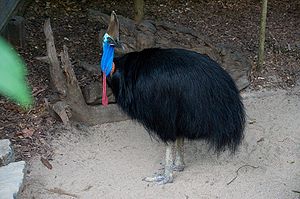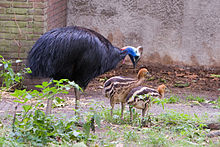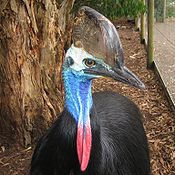- Southern Cassowary
-
Southern Cassowary 
At the The Rainforest Habitat Wildlife Sanctuary, Port Douglas, Australia Conservation status Scientific classification Kingdom: Animalia Phylum: Chordata Class: Aves Order: Casuariiformes Family: Casuariidae Genus: Casuarius Species: C. casuarius Binomial name Casuarius casuarius
(Linnaeus, 1758)[2]
Distribution of the Southern Cassowary in Australia The Southern Cassowary, Casuarius casuarius, also known as Double-wattled Cassowary, Australian Cassowary or Two-wattled Cassowary,[2] is a large flightless black bird. It is a ratite and therefore related to the Emu, Ostrich, and the genus Rhea.
Contents
Description
It has hard and stiff plumage, a brown casque, blue face and neck, red nape and two red wattles hanging down its throat. The three-toed feet are thick and powerful, equipped with a lethal dagger-like claw up to 12 cm (4.7 in) on the inner toe.[2] The plumage is sexually monomorphic, but the female is dominant and larger with a longer casque and brighter-colored bare parts. The juveniles have brown longitudinal striped plumage. It is the largest member of the cassowary family and is the second heaviest bird on earth, at a maximum size estimated at 85 kilograms (190 lb) and 190 centimetres (75 in). Normally this species ranges from 127 to 170 centimetres (50–67 in), with females averaging 58 kilograms (130 lb) and males averaging 29 to 34 kilograms (64–75 lb).[2][3] It is technically the largest Asian bird (since the extinction of the Arabian Ostrich, and previously the Moa of New Zealand) and the largest Australian bird (though the Emu may be slightly taller).
Range and habitat
The Southern Cassowary is distributed in tropical rainforests of Indonesia, New Guinea and northeastern Australia,[4] and it prefers elevations below 1,100 m (3,600 ft) in Australia,[2] and 500 m (1,600 ft) on New Guinea.[5]
Breeding Population and Trends[5] Location Population Trend Southern Papua New Guinea unknown Declining Seram Unknown Unknown Aru Islands Unknown Unknown Northeastern Australia 1,500 to 2,500 Declining **Paluma Range Unknown Declining **McIlwraith Range 1000+ Declining **Jardine River National Park Unknown Unknown Total 2,500+ Declining Behaviour
It forages on the forest floor for fallen fruit and is capable of safely digesting some fruits toxic to other animals. They also eat fungi, and some insects and small vertebrates. The Southern Cassowary is a solitary bird, that pairs only in breeding season, which takes place in late winter or spring. The male builds a nest on the ground;[2] a mattress of herbaceous plant material 5 to 10 centimetres (2–4 in) thick and up to 100 centimetres (39 in) wide. This is thick enough to let moisture drain away from the eggs. The male also incubates the eggs and raises the chicks alone. A clutch of three or four eggs are laid measuring 138 by 95 millimetres (5.4 × 3.7 in). They have a granulated surface and are initially bright pea-green in colour although they fade with age.[2][6]
They make a booming call during mating season and hissing and rumblings otherwise. Chicks will make frequent high-pitches whistles to call the male.[5]
The blade-like claws are capable of killing humans and dogs if the bird is provoked.
Conservation
 Adult male with two chicks at Artis Zoo, Netherlands
Adult male with two chicks at Artis Zoo, Netherlands
Due to ongoing habitat loss, limited range and overhunting in some areas, the Southern Cassowary is evaluated as Vulnerable on the IUCN Red List of Threatened Species.[1] The Australian population is listed as Endangered under Federal and Queensland State legislation.[citation needed] Some threats are through habitat loss (logging), feral animals eating their eggs, hunting, and roadkill.[1][2] Road building, feral animals and hunting are the worst of these threats. It has an occurrence range of 396,000 km2 (153,000 sq mi), and between 10,000 and 20,000 birds were estimated in a 2002 study, with between 1,500 and 2,500 in Australia.[5]
Taxonomy
Presently, most authorities consider the Southern Cassowary monotypic, but several subspecies have been described.[7] It has proven very difficult to confirm the validity of these due to individual variations, age-related variations, the relatively few available specimens (and the bright skin of the head and neck – the basis of which several subspecies have been described – fades in specimens), and that locals are known to have traded live cassowaries for hundreds, if not thousands, of years, some of which are likely to have escaped/been deliberately introduced to regions away from their origin.[7]
Cassowaries, of the family Casuariidae, are closely related to the kiwis in the family Apterygidae, with these two bird families diverging from a common ancestor 40 million years ago. The Southern Cassowary is in the class Aves, which includes all birds; those that can fly as well as those that cannot.
Their binomial name Casuarius casuarius is derived from the Malay word kesuari, meaning cassowary.[8] The Southern Cassowary was first described by Carolus Linnaeus in his 18th century work, Systema Naturae, as Struthio casuarius,[9] from a specimen from Seram, in 1758.[2] It is now the type species of the genus Casuarius.[2]
Footnotes
References
- Animal Life Resource
- Begon, M, Townsend, C.R, Harper, J.R (2006). Ecology: From Individuals to Ecosystems. Pg 16. ISBN 978-1-4051-1117-1
- BirdLife International (2008). Casuarius casuarius. In: IUCN 2008. IUCN Red List of Threatened Species. Downloaded on 05 November 2008.
- BirdLife International (2008(a)). "Southern Cassowary - BirdLife Species Factsheet". Data Zone. http://www.birdlife.org/datazone/species/index.html?action=SpcHTMDetails.asp&sid=4&m=0. Retrieved 06 Feb 2009.
- Beruldsen, G (2003). Australian Birds: Their Nests and Eggs. Kenmore Hills, Qld: self. p. 156. ISBN 0-646-42798-9.
- Clements, James (2007). The Clements Checklist of the Birds of the World (6 ed.). Ithaca, NY: Cornell University Press. ISBN 978 0 8014 4501 9.
- Davies, S. J. J. F. (2002). Ratites and Tinamous. Oxford University Press. ISBN 0 19 854996 2.
- Davies, S.J.J.F. (2003). "Cassowaries". In Hutchins, Michael. Grzimek's Animal Life Encyclopedia. 8 Birds I Tinamous and Ratites to Hoatzins (2 ed.). Farmington Hills, MI: Gale Group. pp. 75–79. ISBN 0 7876 5784 0.
- Frith, H.J et al. (1979). Reader's Digest Complete Book of Australian Birds. Pg 26-27. ISBN 0 909486 63 8
- Gotch, A.F. (1995) [1979]. "Cassowaries". Latin Names Explained. A Guide to the Scientific Classifications of Reptiles, Birds & Mammals. New York, NY: Facts on File. pp. 178–179. ISBN 0 8160 3377 3.
- Linnaeus, C (1758). Systema naturae per regna tria naturae, secundum classes, ordines, genera, species, cum characteribus, differentiis, synonymis, locis. Tomus I. Editio decima, reformata.. Holmiae. (Laurentii Salvii).. p. 155. http://dz1.gdz-cms.de/index.php?id=img&no_cache=1&IDDOC=265100. "S. pedibus tridactylís, vertice palearibusque nudis"(Latin)
- Tellapallet.com Tree of Life
External links
- ARKive - images and movies of the Southern Cassowary (Casuarius casuarius)
- BirdLife Species Factsheet
- IUCN Red List
- Red Data Book
- Southern Cassowary videos on the Internet Bird Collection
- The Cassowary (text and images)
Cassowaries and emus (family: Casuariidae) Subfamily Cassowaries (Casuariinae) CasuariusSouthern Cassowary (C. casuarius) • Dwarf Cassowary (C. bennetti) • Northern Cassowary (C. unappendiculatus) • †C. lydekkiEmus (Dromaiinae) Emu (D. novaehollandiae) (supporting page: †Tasmanian Emu (D. n. diemenensis)) • †Kangaroo Island Emu (D. baudinianus) • †King Island Emu (D. ater) • †D. ocypus†E. guljaruba • †E. gidjuCategories:- IUCN Red List vulnerable species
- Casuarius
- Casuariidae
- Birds of Australia
- Birds of Indonesia
- Birds of Papua New Guinea
- Birds of New Guinea
- Vulnerable fauna of Australia
- Nature Conservation Act endangered biota
- Flightless birds
- Megafauna of Australia
- Megafauna of Eurasia
- Animals described in 1758
- Wingless birds
Wikimedia Foundation. 2010.





